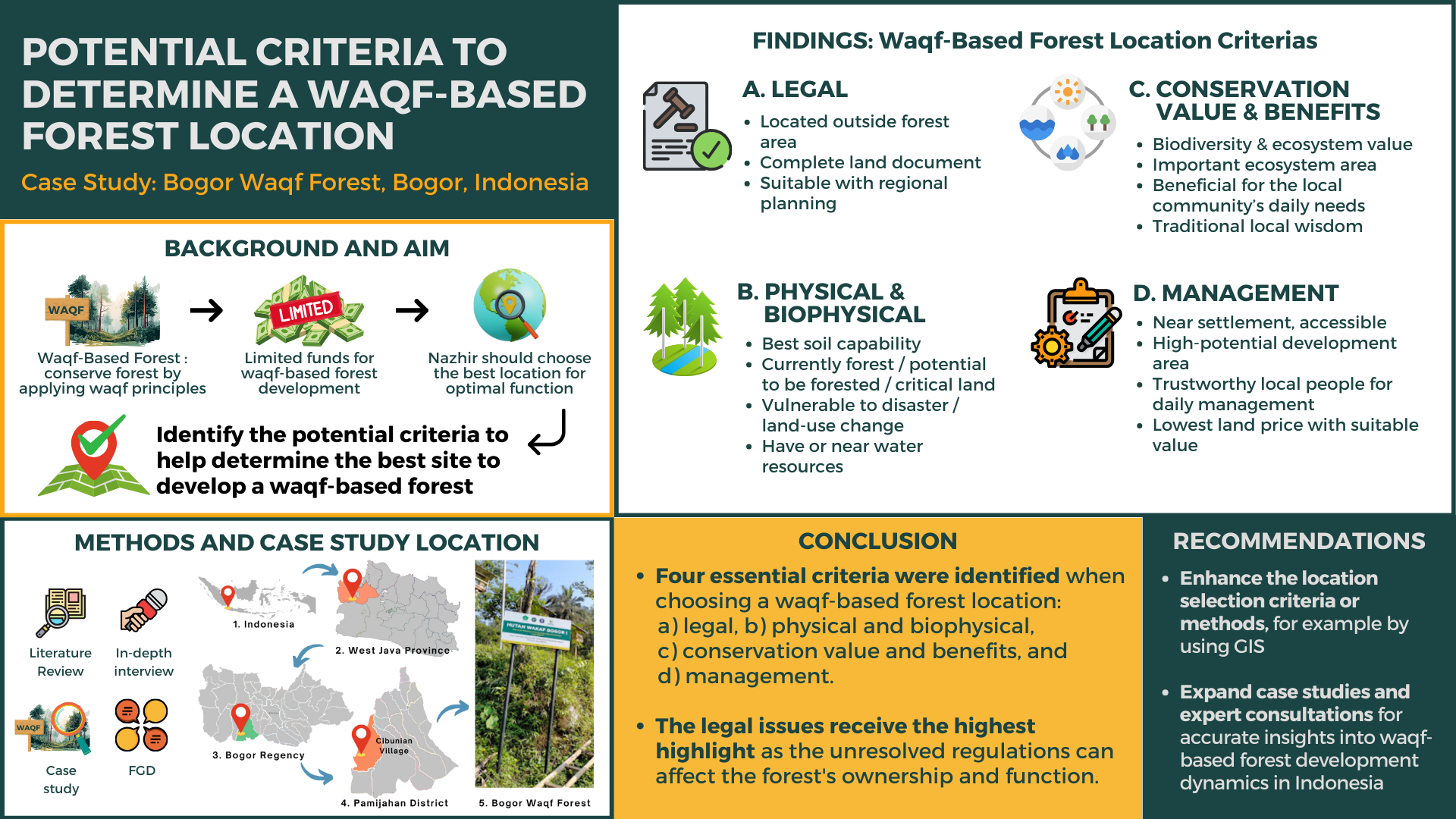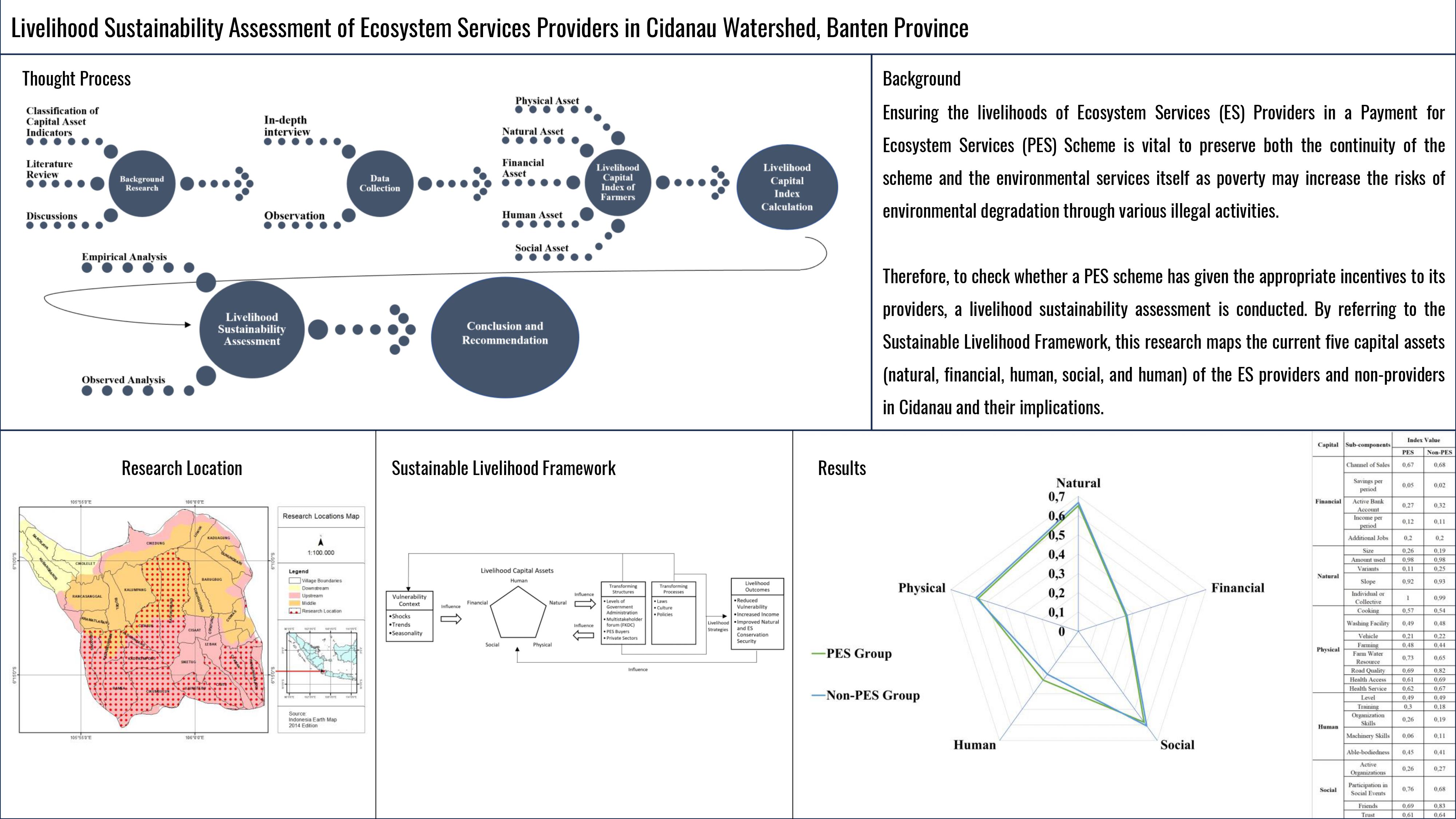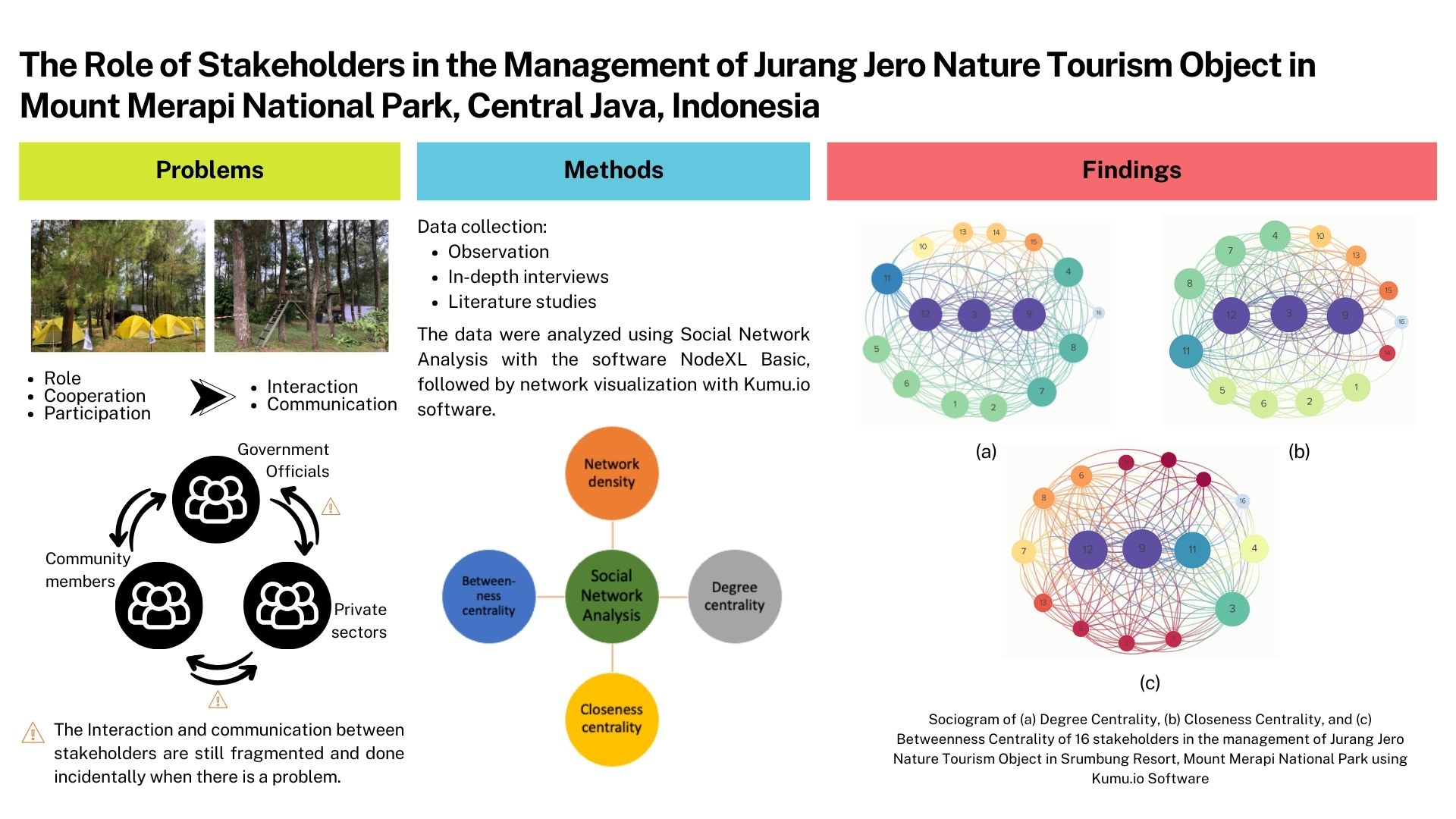Conservation of Damar Mata Kucing (Shorea javanica): A Review on the Aspect of Trade System
Abstract
Damar mata kucing (Shorea javanica) is one of the non-timber forest products (NTFP)s that has been widely managed and utilized by local people around the Pesisir Barat Lampung Province. The majority of repong damar has been cut down, especially during the last 15 years. One of the reasons for decreasing community interest in managing repong dammar is the decreasing of dammar gum prices. This research aimed to analyze the market system of dammar cultivation in Pesisir Barat, Lampung Province. Descriptive analysis was used to determine the local community's knowledge, skill, and opinion in the trading channel. For further analysis, marketing margin and farmers' share were also used to analyze the price differentiation from the producer's level to the consumer's level. Based on the study results, there are three channels of the dammar gum market in Pesisir Barat Lampung. Most of the farmers (up to 85.71% of total) in Pekon Pahmungan use trading channels 1 and 2 to sell their harvested dammar. Meanwhile, based on the analysis of profit margin, it appears that farmers in channels 1 and 2 are trading actors that receive the lowest profit margin (IDR7,100 kg-1 and IDR8,100 kg-1) compared to trading channel 3 (IDR14,000 kg-1). Farmer's share obtained by dammar farmers in this study was 55.30% on channel 1, 52.20% on channel 2, and 76.80% on channel 3. Livelihood, limitation on capital, lack of information and networking, knowledge and abilities to tree management and harvested dammar, knowledge of another use of dammar gum, and the ability to use technology directly affecting farmers' position in the dammar gum trading system.
References
Anasis, M. A., & Sari, M. Y. A. R. (2015). Perlindungan indikasi geografis terhadap damar mata kucing (Shorea javanica) sebagai upaya pelestarian hutan (studi di Kabupaten Pesisir Barat Propinsi Lampung). Jurnal Hukum IUS QUIA IUSTUM, 4, 566–593. https://doi.org/10.20885/iustum.vol22.iss4.art3
Anderson, E., & Weitz, B. (1989). Determinants of continuity in conventional industrial channel dyads, Marketing Science, 8, 310–323. https://doi.org/10.1287/mksc.8.4.310
Azwar, S. (2012). Penyusunan skala psikologi (ed. 2). Yogyakarta: Pustaka Pelajar.
Barbier, E. B., & Schulz, C. E. (1997). Wildlife, biodiversity and trade. Environment and Development Economics, 2(2), 145–172. https://doi.org/10.1017/S1355770X97000144
Blenkhorn, D. L., & MacKenzie, H. F. (1996). Interdependence in relationship marketing. Asia-Australia Marketig Journal, 4, 25–30. https://doi.org/10.1016/S1320-1646(96)70266-6
Bouamrane, M. (1996). A season of gold–putting a value on harvests from Indonesia agroforest. Agroforestry Today, 8, 8–11.
[BPS] Badan Pusat Statistik. (2018). Kabupaten Pesisir Barat dalam angka 2018. Lampung: Badan Pusat Statistik Kabupaten Lampung Barat.
Bromley, D. W. (1992). The commons, common property, and environmental policy. Environmental and Resource Economics, 2, 1–17. https://doi.org/10.1007%2FBF00324686
Curtois P., & Subervie J. (2015). Farmer bargaining power and market information services. American Journal of Agricultural Economics, 97, 953–977. https://doi.org/10.1093/ajae/aau051
Devaux, A., Torero, M., Donovan, J., & Horton, D. (2016). Innovation for inclusive value-chain development: Successes and challenges. Washington DC: International Food Policy Research Institute.
Febrianto, P. T., & Rahardjo (2005) . Eksploitasi hubungan pandega-juragan dalam moderenisasi perikanan tangkap di Desa Grajagan, Kecamatan Purwohardjo, Kabupaten Banyuwangi. Sosiosains, 18, 325–339.
Fischer, C. (2010). Does trade help or hinder the conservation of natural resources? Review of Environmental Economics and Policy, 4, 103–121. https://doi.org/10.1093/reep/rep023
Gilbert, D. E. (2017). The 'capitalist squeeze' and the rise and fall of Sumatra's Krui agroforests. Human Ecology, 45, 711–717. https://doi.org/10.1007/s10745-017-9932-3
Guest, G., Bounce, A., & Johnson, L. (2006). How many interviews are enough? An experiment with data saturation and variability. Field Methods, 18, 59–82. https://doi.org/10.1177/1525822X05279903
Haris, U., Gonasryah, I., & Anwar, A. (2000). Analisis faktor-faktor penentu kelembagaan tataniaga petani karet di sentra produksi karet rakyat di Sumatera Selatan. Ekonomi dan Keuangan Indonesia, 48, 83–106. Retrieved from https://www.lpem.org/repec/lpe/efijnl/200004
Hulu, H. L., Iswandi, R. M., & Indarsyih, Y. (2017). Faktor-faktor yang mempengaruhi konversi lahan perkebunan cengkeh di Desa Tolong Kecamatan Lede Kabupaten Pulau Taliabu Provinsi Maluku Utara. Jurnal Ilmiah Agribisnis, 2, 24–28. https://doi.org/10.33772/jia.v2i1.6692
Jensen, R. (2007). The digital provide: Information (technology), market performance, and welfare in the South Indian fisheries sector. The Quarterly Journal of Economics, 122, 879–924. https://doi.org/10.1162/qjec.122.3.879
Kartikawati, S. M., Zuhud, E. A. M., Hikmat, A., & Kartodiharjo, H. (2014). Analisis kinerja kelembagaan tata niaga pasak bumi (Eurycoma longifolia jack) yang berkelanjutan di Kabupaten Kubu Raya dan Kota Pontianak, Kalimantan Barat. Jurnal Penelitian Sosial dan Ekonomi Kehutanan, 11, 153–164. https://doi.org/10.20886/jpsek.2014.11.2.153-164
Karyono, O. K., Sumadiwangsa, S., & Poernama, B. M. (1996). Suatu kajian tentang produksi dan ekonomi damar di Sumatera Barat. Jurnal Peneliian Hasil Hutan, 14, 355–365. https://doi.org/10.20886/jphh.1996.14.9.355-365
Kusters, K., Perez, M. R., de Foresta, H., Dietz, T., Ros-Tonen, M., Belcher, B., ..., & Wollenberg, E. (2008). Will agroforestry vanish? The case of damar agroforest in Indonesia. Human Ecology, 36, 357–370. https://doi.org/10.1007/s10745-008-9168-3
Kuswardani, R. A., Isnaini, Siregar, R. S., & Sembiring, S. (2017). The role of government in supporting the development of agriculture in North Sumatra. IOSR Journal, 10, 96–102. https://doi.org/10.9790/2380-0120196102
Mary, F., & Michon, G. (1987). When agroforest drive back natural forest: A socio-economic analysis of rice-agroforest in Sumatra. Agroforestry System, 5, 27–55. https://doi.org/10.1007/BF00046412
Menggala, S. (2018). Improving Cinnamomum burmannii Blume value chains for farmer livelihood in Kerinci, Indonesia. European Journal of Medicine and Natural Sciences, 2, 22–42. https://doi.org/10.26417/ejmn.v2i1
Michon, G., Mary, F., & Bompard, J. (1987). Multistoried agroforestry garden system in West Sumatra, Indonesia. Agroforestry Systems, 4, 315–338. https://doi.org/10.1007/BF00048106
Mkhawani, K., Motadi, S. A., Mabapa, N. S., Mbhenyane, X. G., & Blaauw, R. (2016). Effects of rising food prices on household food security on femaleheaded households in Runnymede Village, Mopani District, South Africa. South African Journal of Clinical Nutrition, 29, 69–74. https://doi.org/10.1080/16070658.2016.1216504
Murniati, Garrity, D. P., & Gintings, A. Ng. (2001). The contribution of agroforestry systems to reducing farmers' dependence on the resources of adjacent national parks: a case study from Sumatra, Indonesia. Agroforestry Systems, 52, 171–184. https://doi.org/10.1023/A:1012047602192
Mutuo, P. K., Cadisch, G., Albrecht, A., Palm, C. A., & Verchot, L. (2005). Potential of agroforestry for carbon sequestration and mitigation of greenhouse gas emissions from soils in the tropics. Nutrient Cycling in Agroecosystems, 71, 43–54. https://doi.org/10.1007/s10705-004-5285-6
Nyhus, P., & Tilson, R. (2004). Agroforestry, elephants, and tigers: Balancing conservation theory and practice in human-dominated landscapes of Southeast Asia. Agriculture, Ecosystems and Environment, 104, 87–97. https://doi.org/10.1016/j.agee.2004.01.009
Puspitasari, A. W. (2015). Farmer's prosperity: How to increase farmer's bargain power (in Islamic perspective). Social and Behavioral Sciences, 211, 455–460. https://doi.org/10.1016/j.sbspro.2015.11.060
Ruhimat, I. S. (2017). Peningkatan kapasitas kelembagaan kelompok tani dalam pengembangan usahatani agroforestry: Studi kasus di Desa Cukangkawung, Kecamatan Sodonghilir, Kabupaten Tasikmalaya, Provinsi Jawa Barat. Jurnal Penelitian Sosial dan Ekonomi Kehutanan, 14, 1–17. https://doi.org/10.20886/jpsek.2017.14.1.1-17
Sudiyono, A. (2002). Pemasaran pertanian. Malang: UMM Press.
Sudrajat, J., & Arani, N. (2016). Institutional economic reconstruction by optimizing the role of middle-men. MIMBAR, 32, 65–73. https://doi.org/10.29313/mimbar.v32i1.1743
Triyono, P. (2000). Perkembangan posisi tawar petani dalam pemasaran damar mata kucing di Lampung. Jurnal Sosial Ekonomi, 1, 4961.
Wohlgenant, M.K. (2001). Marketing margins: Empirical analysis. Handbook of Agricultural Economics, 1, 933–970. https://doi.org/10.1016/S1574-0072(01)10024-1
Wollenberg, E., Nawir, A., Uluk, A., & Pramono, H. (2001). Income is not enough: The effect of economic incentives on forest product conservation A comparison of forest communities dependent on the agroforests of Krui, Sumatra, and natural dipterocarp forests of Kayan Mentarang, East Kalimantan. Bogor: Center for International Forestry Research (CIFOR)
Yustika, A. E. (2008). Ekonomi kelembagaan. Definisi, teori, dan strategi. Malang: Bayumedia Publishing.
Zuhud, E. A. M. (2007). Sikap masyarakat dan konservasi. Suatu analisis kedawung (Parkia timoriana (DC) Merr.) sebagai stimulus tumbuhan obat bagi masyarakat, kasus di Taman Nasional Meru Betiri [dissertation]. Bogor: Institut Pertanian Bogor.
Authors

This work is licensed under a Creative Commons Attribution 4.0 International License.
Jurnal Manajemen Hutan Tropika is an open access journal which means that all contents is freely available without charge to the user or his/her institution. Users are allowed to read, download, copy, distribute, print, search, or link to the full texts of the articles in this journal without asking prior permission from the publisher or the author. This is in accordance with the Budapest Open Access Initiative (BOAI) definition of open access.







